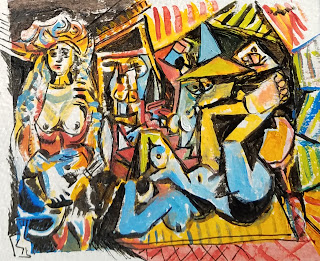 |
| My interpretation of Picasso's interpretation |
Version O, was the last of the series of Women of Algiers after Delacroix painted by Picasso in homage to his great friend and rival, Henri Matisse. From June to October of
1955, the Musée des Arts Décoratifs in Paris displayed the entire series
together as part of a retrospective exhibition of the last 55 years of
Picasso's career. Unfortunately these paintings have not been on view together
since the original sale at Kahnwaller’s gallery in Paris in 1956. They were for sale as
a complete set and bought by New York collectors Victor and Sally
Ganz for $212,000. They later sold off eleven of the paintings to museums and
private collectors. Since then, pieces have scattered to private collections and
various museums.
 |
| Version O was depicted in LifeMagazine Dec 27, 1968. |
The painting has wonderful hatch lines and pattern, recalling the first interpretation, Version A. It’s got a bit of Matisse in it and Jacqueline Roque’s face is clearly on
the left side. The black, as only Picasso can use black, sings! New York Magazine's Jerry Saltz calls Version O "an epic master class on the ways of
painting, art history, color, structure, and form.”
In looking at his 15 renditions (or interpretations) of The
Women of Algiers, one may suggest he might not have been political but he was radical.
 |
| My interpretation of Delacroix's painting of a fantasy harem |
His sympathies were for the Algerians in 1954 as they
rebelled yet again under French colonial rule. Incredibly, given Picasso's history of splaying naked women on the canvas for the male gaze, this painting was picked up by the rebellious Algerian women as an emblem of their strength. They felt that he had taken Eugene Delacroix's scene of submissive sirens and articulated a new idea of Women in their private apartment.These were women of strength and solidarity, not to be messed with!
In 1997, upon the death of
art collector widow Sally Ganz, the Version O was sold for 31.9 million dollars and then
auctioned through Christie's in 2015. It broke records selling for $179 million to an Arab Sheik,
Former Prime minister of Qatar, Hamid bin Jassim bin Jaber Al Thani.
Unknown
until the Panama Papers were leaked, is that the Ganz heirs appeared to have sold the collection months
before the auction. "The key player in the transaction was a corporation based
on Niue, a speck of an island in the
South Pacific. The company was named Simsbury International Corp. Simsbury International appears to have been created
solely for the Ganz transaction. It was incorporated in April 1997. A month
later it purchased the collection.Simsbury’s
registered agent was Mossack Fonseca. Employees of the Panamanian law firm
served as Simsbury International’s “nominee” directors, stand-ins who
controlled the company on paper but who exercised no real authority over its
activities. These paper directors signed agreements on the company’s behalf
with a bank, an auction house and an art shipping company. Ownership
of the company was held through “bearer shares.”
These
are simply certificates that allow whoever holds the paper to anonymously
transfer or claim their value. Today, they are banned in many countries because
of their usefulness to those who want to engage in tax evasion and money
laundering. The
man who had power of attorney for Simsbury, and thus exercised control over the
company and its bank account, was British billionaire Joseph Lewis. Then the richest man in England, Lewis made his fortune betting
on currency movements. He was also Christie’s largest shareholder.
| The game "Auctioneer" |
The
Ganz catalogue stated “Christie’s has a direct financial interest in all property
in this sale,” but the terms of that interest were never explained. The
Ganz auction would help turn 1997 into one of Christie’s biggest years for
sales up until then. The auctioneer raked in more than $2 billion that year."
-->


No comments:
Post a Comment